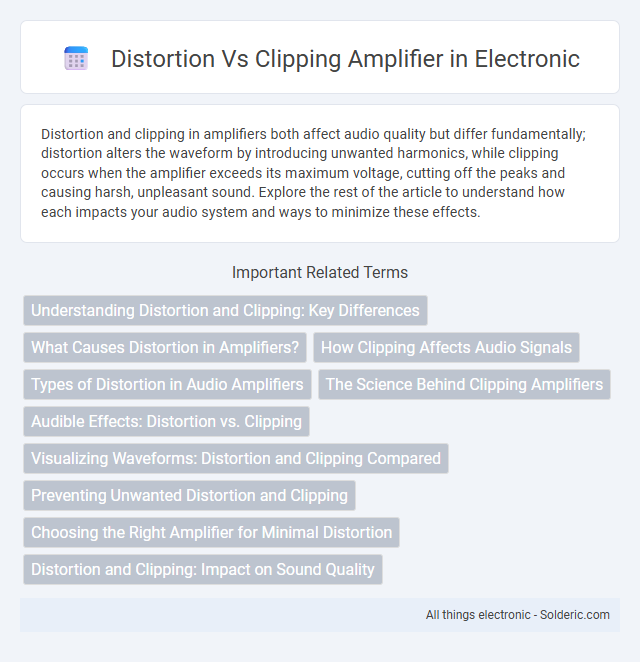Distortion and clipping in amplifiers both affect audio quality but differ fundamentally; distortion alters the waveform by introducing unwanted harmonics, while clipping occurs when the amplifier exceeds its maximum voltage, cutting off the peaks and causing harsh, unpleasant sound. Explore the rest of the article to understand how each impacts your audio system and ways to minimize these effects.
Comparison Table
| Aspect | Distortion Amplifier | Clipping Amplifier |
|---|---|---|
| Definition | Alters the input signal by changing its waveform, producing harmonic or non-harmonic distortions. | Limits the signal amplitude by cutting off peaks, creating a clipped waveform. |
| Signal Modification | Introduces intentional or unintentional waveform changes causing tonal coloration. | Truncates the waveform peaks, resulting in a flattened, clipped output. |
| Purpose | Used for creative sound effects and enhancing harmonic content. | Prevents signal overload and protects circuits or creates an aggressive sound effect. |
| Effect on Sound | Produces warmer or altered tones with added harmonics. | Generates harsh, buzzy, or gritty tones by waveform clipping. |
| Common Usage | Guitar pedals, audio processors, music production. | Overdrive pedals, limiter circuits, signal protection. |
| Technical Cause | Non-linear amplification resulting in waveform shaping. | Signal amplitude exceeds amplifier limits causing peak clipping. |
Understanding Distortion and Clipping: Key Differences
Distortion in amplifiers occurs when the output signal deviates from the input due to nonlinearities, affecting sound quality by altering amplitude or frequency components. Clipping specifically refers to the amplifier's inability to increase voltage beyond its maximum limit, resulting in a flattened waveform peak and harsh, unpleasant audio artifacts. Understanding these differences is essential for audio engineers aiming to optimize amplifier performance and minimize unwanted sonic degradation.
What Causes Distortion in Amplifiers?
Distortion in amplifiers is primarily caused by nonlinearities in the amplification process, where the output signal deviates from the input signal's shape. Clipping occurs when the amplifier is driven beyond its maximum output capacity, causing the peaks of the signal to be "clipped" and resulting in a harsh, clipped waveform. Distortion can also arise from components like transistors and tubes operating outside their linear region, leading to harmonic and intermodulation distortion.
How Clipping Affects Audio Signals
Clipping in amplifiers causes audio signals to exceed the maximum voltage the device can handle, resulting in a distorted waveform with flattened peaks. This distortion produces harsh, unpleasant sounds and introduces harmonic artifacts that degrade sound quality. Unlike subtle distortion, clipping creates audible signal degradation by abruptly cutting waveform peaks, which can damage speakers if persistent.
Types of Distortion in Audio Amplifiers
Audio amplifiers exhibit various types of distortion, with harmonic distortion and intermodulation distortion being the most significant in affecting sound quality. Harmonic distortion occurs when the amplifier introduces additional harmonics that were not present in the original signal, altering the timbre of audio output. Clipping distortion arises when the amplifier is driven beyond its maximum output capacity, causing waveform peaks to flatten and resulting in harsh, unpleasant sound artifacts.
The Science Behind Clipping Amplifiers
Clipping amplifiers produce distortion by intentionally driving the signal beyond the amplifier's limits, causing the waveform to clip and create harmonic overtones that add a gritty, aggressive character to the sound. This hard clipping generates a series of odd-order harmonics that contribute to the perceived intensity and warmth in audio signals, commonly used in electric guitar effects. Understanding this process helps you control distortion levels and tonal quality for desired sonic textures.
Audible Effects: Distortion vs. Clipping
Distortion in an amplifier produces a warm, harmonically rich sound by smoothly altering the waveform, often preferred for musical expression and character. Clipping occurs when the amplifier is pushed beyond its maximum output, resulting in harsh, abrupt waveform cuts that generate unpleasant, high-frequency noise. Your choice between distortion and clipping affects the audible quality, with distortion providing a more musically pleasing effect while clipping can cause ear fatigue and damage to speakers.
Visualizing Waveforms: Distortion and Clipping Compared
Visualizing waveforms reveals that distortion alters the shape by adding harmonic overtones, creating smoother waveform modifications, while clipping sharply cuts the peaks, producing harsh, flattened tops. Distortion maintains some waveform integrity, resulting in richer tones, whereas clipping generates pronounced square wave patterns leading to increased harmonic saturation and potential signal damage. Understanding these visual differences helps you control your amplifier's sound character more precisely for desired audio effects.
Preventing Unwanted Distortion and Clipping
Preventing unwanted distortion and clipping in amplifiers requires careful gain staging to maintain signal integrity and avoid exceeding the amplifier's linear operating range. Utilizing high-quality components and implementing proper headroom ensures the signal remains within acceptable amplitude limits, reducing harmonic and intermodulation distortion. Employing soft clipping circuits or limiter designs can further minimize abrupt signal clipping, preserving audio clarity and dynamic range.
Choosing the Right Amplifier for Minimal Distortion
Selecting an amplifier with low total harmonic distortion (THD) ensures cleaner sound reproduction, preserving audio fidelity and clarity. Clipping occurs when the amplifier is pushed beyond its maximum capacity, causing harsh, unpleasant distortion that can damage speakers over time. To minimize distortion, you should prioritize amplifiers with adequate headroom and high signal-to-noise ratios, ensuring your sound remains crisp and undistorted even at higher volumes.
Distortion and Clipping: Impact on Sound Quality
Distortion in amplifiers alters the original audio signal by adding harmonic content, often resulting in a warmer or more aggressive tone, while clipping occurs when the amplifier is pushed beyond its maximum output limit, producing harsh, unpleasant sound artifacts. The impact on sound quality varies: mild distortion can enhance character, but clipping generally degrades clarity and introduces unwanted noise. Understanding the differences helps you maintain optimal sound fidelity and avoid damaging speakers or audio equipment.
distortion vs clipping amplifier Infographic

 solderic.com
solderic.com